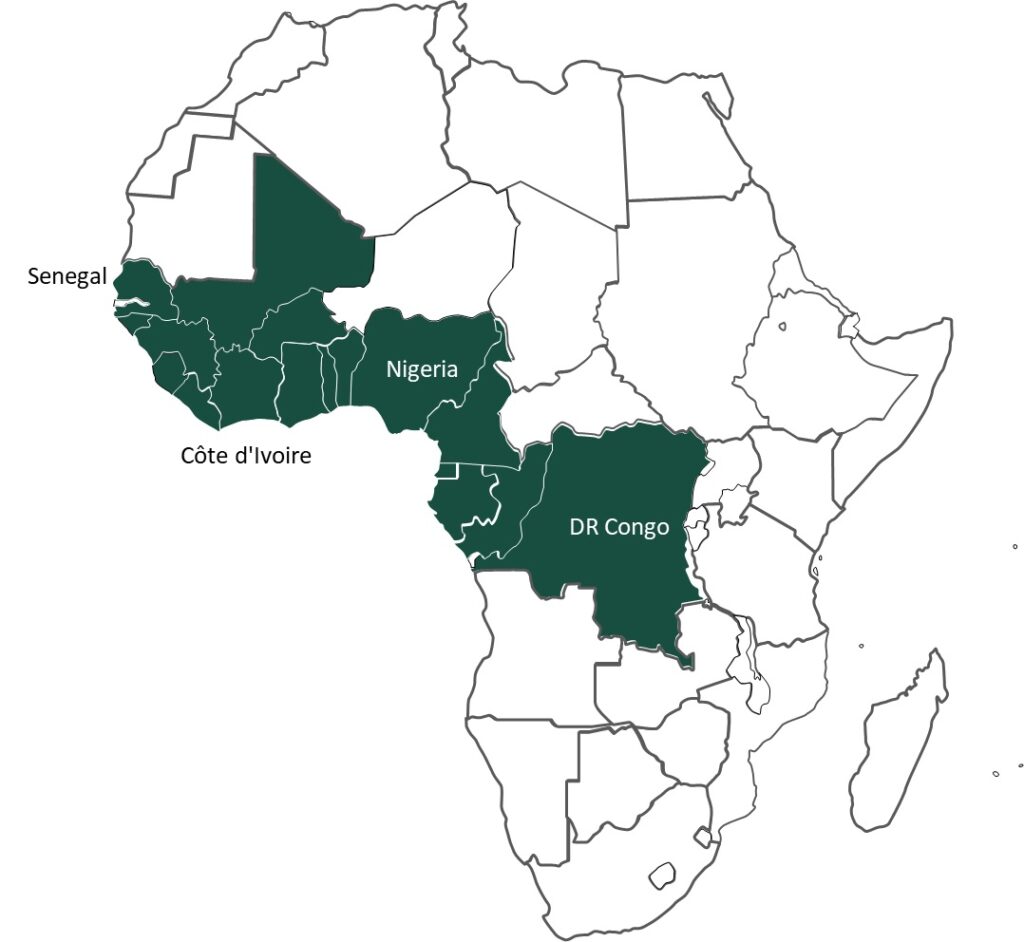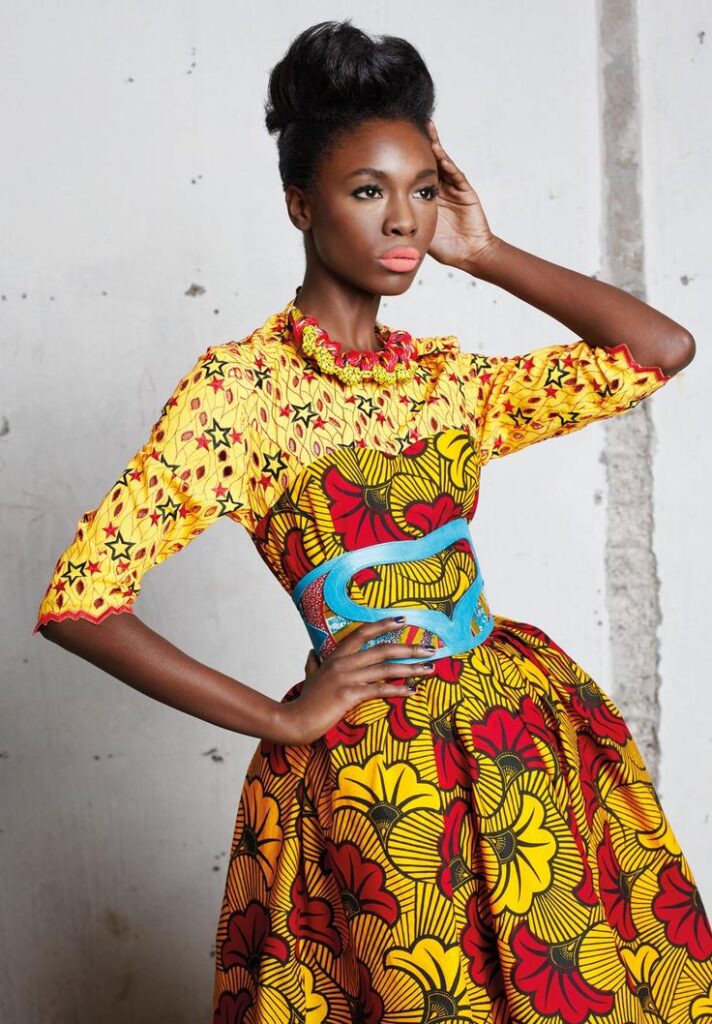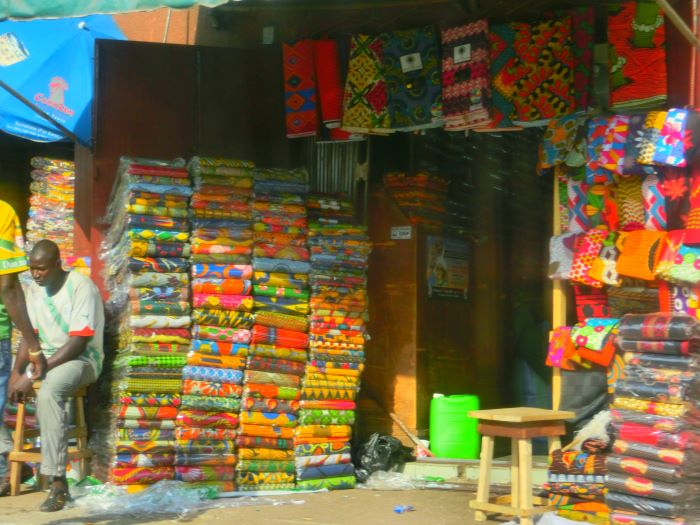The Fashion Belt on the African continent

In my opinion, the country with the largest number of fasihon lovers in Africa is Senegal. As I walk along the streets, I often find myself subconsciously turning back to look at ladies as they pass by. They are slim, have long limbs, high hips, small faces, long, narrow eyes and above all, they are elegantly dressed.
Their favorite tailors produce their outfits as tailor-made clothes. They utilize printed fabrics purchased at markets and the designs are elaborate in detail. For example, the sleeve edges are decorated with beads, the hem of an A-line skirt has decorative frills, or the outfit is exquisitely asymmetrical.
By referring to stylebooks, they are able order outfits to be made in their own ideas, concepts and visualization. They arrange to produce head-scarfs, bags, and shoes using the same fabrics. It is no wonder people say, ‘Senegalese people spend all their money on clothes’. One can tell when they see the elegantly and modernly crafted dresses with superior detail.
It is natural that men should keep their bodies in a good shape by doing exercises, isn’t it?"
- A sengalease man
Ghana, which is located about 2,000km southeast of Senegal, is also quite competitive. There is a website-based drama called ‘An African City’, which is recognized as the Ghanaian ‘Sex and the City’. The drama is founded on a similar concept to the original one; five modern, workingwomen living in the Ghanaian capital Accra, talking frankly about love, life and fashion. Similarly, women’s fashion is the object of public attention just like the original series.
They wear tailor-made; sleeveless dresses with elegant, printed fabrics and carry brand-name bags. Alternatively, they dress classy in stylish European style suits with 5-inch heels and standout African accessories. Their outfits combine traditional, Ghanaian garments with Western attire.

Although the setting of the drama is that the main characters are well off and have lived overseas, if we observe common Ghanaians appearing in the drama as supporting actors, one can notice that their fashion is not so far off from that of the main characters. The townscape, lifestyle, and restaurants in the drama are a realistic reflection of the middle class life in urban areas in Africa.
In Africa, the term ‘fashionable people’ is not limited to women only. There are men called ‘Sapeurs’ in the Republic of the Congo and the Democratic Republic of the Congo. They are dandies who dress in suits, ties and shoes made by Western brands such as Gaultier and Louis Vuitton. Their balance in color and elegance are rock and avant-garde in an environment where unpaved roads and poor shack-like buildings stand in rows. Actually, this isn’t surprising because their fashion originated from a social movement of anti-colonialism. Diageo brand beer, Guinness used the ‘Sapeurs’ fashion for one of their campaigns and NHK in Japan also did a feature on them.

The ‘fashion belt’ on the African continent
The area surrounding the Gulf of Guinea from Senegal located in the west edge of the African continent to Guinea, Cote d’Ivoire, Ghana, Nigeria, the Republic of the Congo, and the Democratic Republic of the Congo can be called the African fashion belt. People in the area have a high sense of beauty and are keen what they wear, and the 100% cotton, wax-printed fabrics called ‘Panya’, etc. are widely distributed. It is common culture for the fabrics to be tailored into custom-made clothes.
The area is called the West African region and the Central African region geographically and linguistically, they are mostly francophone (French-speaking).
The Fashion belt in Africa

Actis, a British investment company, has found a big business opportunity in this fabric culture. Actis has invested widely in home consumption related businesses such as shopping malls and the retail sector in Africa; ‘Vlisco’ is one such investment.
Its products are high quality, wax-printed fabrics and their coloring and designs are traditional but modern and sophisticated, which is ideal to tailor them in a contemporary silhouette. Check the following picture of one of their products. The price of the fabrics is nearly 10,000 Japanese Yen for a six-yard, suit-length piece. This is the kind of fashion that the middle class people in Africa prefer.
Vlisco’s fabrics are produced in the Netherlands and are sold in countries all along the fashion belt including Cote d’Ivoire (28 shops), Ghana (4 shops), Togo (27 shops), and the Democratic Republic of the Congo (9 shops). The company is a major retailor of fabrics for the middle-income group, and has affiliated companies of fabric brands such as Uniwax and Woodin in Cote d’Ivore, which offer fabrics at cheaper prices than Vlisco; from about 3,000 to 5,000 Japanese Yen for six yards.

Vlisco’s fashion (Vlisco website)
The impact affects the Japanese fashion industry
Cote d’Ivoire and Burkina Faso are originally the world’s well-known cotton producing centers. Abidjan, the capital city of Cote d’Ivoire, was the most fashionable city in Africa and had a couple of large-scale textile factories in the 1980s. Fashion must have enjoyed their city lives during that period in time. For a long period of time, political instability caused stagnation, but, over the last year or so, investment has been growing in the country.
The author visited a textile factory that was once bankrupt but is currently under reconstruction by a local entrepreneur. The author learned that the factory was an affiliated factory to Unitika until around the 1990s. The factory aims to revitalize the textile production in Cote d’Ivoire by carrying out maintenance of production machines labelled ‘TOYODA’ or ‘MURATA’.
Of late, collaborations have been recently observed between Japan and the fashion belt countries. One such company in partnership is the denim manufacturer named Japan Blue, which sells ‘Momotaro-Jeans’, etc., and is immensely supported by Japanese people keen in fashion. In November 2014, the company began selling jeans made from fabrics woven from cotton produced in Cote d’Ivoire. A pair of jeans is priced at 13,000 Japanese Yen. The cotton in Cote d’Ivoire is said to be close to the original strain and is rich in texture. In May 2014, the United Allows began selling men’s jackets and pants made from cotton fabrics woven by local craftsmen in Burkina Faso.
Last year, French trade company CFAO (whose ownership Toyota Tsusho took over), announced that it would undertake a retailing business in Africa in partnership with French leading retailor, Carrefour. The eight targeted countries are those along this fashion belt (i.e. Senegal, Cote d’Ivoire, Ghana, Nigeria, Cameroon, Gabon, the Republic of the Congo, and the Democratic Republic of the Congo). The arrival of Carrefour will be the first step in initiating sales of foreign clothing brands in Africa. The first shop will be opened in 2015 in Cote d’Ivoire. Of course, Japanese companies will also have a chance to access the market.
Paying attention to personal appearance
In the drama previously mentioned, ‘An African City’, scenes of women doing exercises in a gym appears often. In addition, one of the characters is a vegetarian. In fact, in African cities, we often come across people who only eat vegetables, or white meat or fish with the sole purpose of dieting or shaping up.
Men are keen on shaping up, too. A definitely surprising scene for first-time visitors to Senegal’s capital Dakar is gatherings for running and outdoor exercise at seashore beaches organized every evening. The number of participants is probably around 200 people. One can observe men gathering in twos and threes after work and jogging back and forth in groups silently along the beach.
People gather around a number of muscle and weight training machines (including fake ones) so as to build up their bodies. When I asked, ‘Why do so many people do exercises enthusiastically?’ one answered, ‘It is natural that men should keep their bodies in a good shape by doing exercises, isn’t it?’
First of all, it is known that Africans are essentially stylish. Even those that are very poor won’t go out of their homes wearing dirty shoes. Even though dust hangs in the air along unpaved roads, one will still find people wearing white shoes or white jeans. Their shirts are unwrinkled and the clothes are washed every day. Mothers wash clothes by hand from the morning to the evening since they don’t have washing machines.
At the cheapest, African fabrics cost about 1,000 to 2,000 Japanese Yen, even if they are bought at an open-air market. Paying tailors also costs about 1,000 Japanese Yen. Even though the prices are never cheap, they are willing to spend for purposes of their fashion and appearance. That is their sense of beauty.

Fashion is the way of living
Being neatly dressed is quite important in the African society, especially in the countries along the fashion belt. They have a bigger interest in how much they are loved, respected, and have personal relationships than in how much money they have. Sometimes, the amount of money spent on their clothing and appearance exceeds their disposable incomes. One was misjudge the market if they assumed that poor people who don’t have enough to eat would never spend money on their fashion and fitness.
Designs of the printed fabrics along the fashion road are originally determined according to their ethnic groups, their hometowns and classes are identified by those designs and patterns. However, Vlisco produces their products in the Netherlands and cheap printed fabrics made in China have recently started flowing into the African market. As shopping malls spread, high-end brands and fast fashion from the Western countries are also getting popular. In Cote d’Ivoire, there are three fast fashion shops of Spanish brand ‘Mango’, and there is ‘Zara’ in the Democratic Republic of the Congo.
However, they are critically selecting between both the traditional and the Western clothes based on their sense of beauty. It not always the case that internationally branded clothes would sell well. When we talked to a local business person the other day about a plan to sell a Japanese fashion brand in Africa, the person said to us, ‘Why are you bringing such a cheap product? We would like you to sell a product with higher quality’. As seen by ’Sapeurs’ in the Congos, they don’t just long for foreign products; for them, fashion is their way of living.
